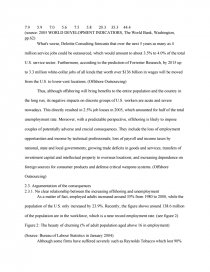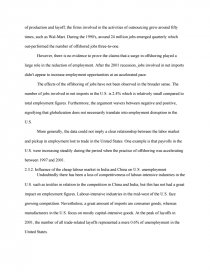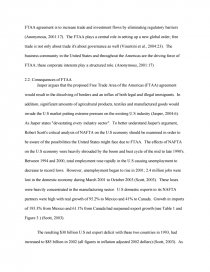Losing America's Livelihood
Essay by review • March 12, 2011 • Research Paper • 4,537 Words (19 Pages) • 2,167 Views
Essay Preview: Losing America's Livelihood
1. Brief overview of Jasper's article
William Jasper is an investigative journalist who has researched and written on various topics, including foreign and domestic policies and national security. In his article "Losing America's Livelihood", the author's premise of writing the paper is to awaken and educate the American people on the potential issues that lie ahead for the United States if government policies and actions regarding U.S employment don't change, even boldly stating that the U.S is headed for Third World status.
Throughout the article, there are various areas where the author is critical of and in turn concerned about. It is the opinion of these authors that government regulatory policies and intervention, job offshoring and the FTAA (Free Trade of the Americas) are the main issues Jasper is highlighting and therefore resulting in unemployment in the United States. In addition, Jasper fears that national sovereignty as he knows will cease to exist. Every industry including shrimp, tool and die, sawmill owners, ranchers and farmers, manufacturers, software engineers and computer consultants are all facing extinction due to these issues. This paper will examine in detail the three areas in question, listing the benefits and consequences of each. Afterwards, we will conclude with an overview of how credible Jasper's argument is.
2. Relationship between offshoring and unemployment
2.1. Introduction of offshoring
In the U.S. the offshoring implies the transfer of high-wage U.S. jobs to lower-cost overseas locations. It is enabled by improved communications technologies and driven by the desire of corporations to establish a business presence in potentially lucrative foreign markets as well as to take advantage of the lower costs of production and skilled labor in those markets. (Offshore Outsourcing)
There are two major types of job offshoring. The first is workplace relocation or activities being taken by the same company cross boarder, with a major proportion of outsourcing activities being performed by the same company in another country. The other major form of offshoring is the activities are outsourced to a subcontractor in foreign country.
2.2.Consequences of offshoring
Originally the emphasis of offshoring in the U.S. concentrated on the manufacturing sector and low-skilled jobs which, however, has led to a loss of 3 million manufacturing jobs in the past decade already. In recent years, the trend of offshoring has been transferred to the more complex engineering and design services. As a result, workers with secondary and tertiary educational background have suffered from sever unemployment from 1990 to 2001, 35.3% and 44.4% respectively (see figure 1). Consequently, unemployment among the latter group that consist of electrical engineers, computer scientists, and information technology professionals has been increasing over the past three years, and reached historically high levels in 2003. This trend is particularly concerned by many American economists who considered it could eventually weaken America's leadership in technology and innovation, a threat that has serious implications for the national security as well as economic competitiveness. (Offshore Outsourcing)
Figure 1: Unemployment
Unemployment Unemployment by level of educational attainment (% of total unemployment)
Male
% of male labour force Female
% of female labour force Total
% of total labour force
Primary
Secondary
Tertiary
1990-92 2000-02 1990-92 2000-02 1990-92 2000-02 1999-2001 1999-2001 1999-2001
7.9 5.9 7.0 5.6 7.5 5.8 20.3 35.3 44.4
(source: 2005 WORLD DEVELOPMENT INDICATIORS, The World Bank, Washington, pp.62)
What's worse, Deloitte Consulting forecasts that over the next 5 years as many as 4 million service jobs could be outsourced, which would amount to about 3.5% to 4.0% of the total U.S. service sector. Furthermore, according to the prediction of Forrester Research, by 2015 up to 3.3 million white-collar jobs of all kinds that worth over $136 billion in wages will be moved from the U.S. to lower-cost locations. (Offshore Outsourcing)
Thus, although offshoring will bring benefits to the entire population and the country in the long run, its negative impacts on discrete groups of U.S. workers are acute and severe nowadays. This directly resulted in 2.5% job losses in 2005, which amounted for half of the total unemployment rate. Moreover, with a predictable perspective, offshoring is likely to impose couples of potentially adverse and crucial consequences. They include the loss of employment opportunities and income by technical professionals; loss of payroll and income taxes by national, state and local governments; growing trade deficits in goods and services; transfers of investment capital and intellectual property to overseas locations; and increasing dependence on foreign sources for consumer products and defense critical weapons systems. (Offshore Outsourcing)
2.3. Argumentation of the consequences
2.3.1. No clear relationship between the increasing offshoring and unemployment
As a matter of fact, employed adults increased around 35% from 1980 to 2000, while the population of the U.S. only increased by 23.9%. Recently, the figure shows around 138.6 million of the population are in the workforce, which is a near record employment rate. (see figure 2)
Figure 2: The beauty of churning (% of adult population aged above 16 in employment)
(Source: Bureau of Labour Statistics in January 2004)
Although some firms have suffered severely such as Reynolds Tobacco which lost 90% of production and layoff, the firms involved in the activities of outsourcing grew around fifty times, such as Wal-Mart. During the 1990's, around 24 million jobs emerged quarterly which out-performed the number of offshored jobs three-to-one.
However, there is no evidence to prove the claims that a surge in offshoring played a large role in the reduction of employment. After the 2001 recession,
...
...
















